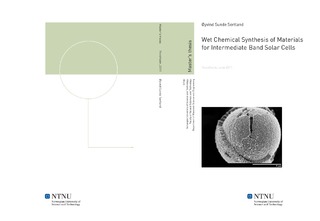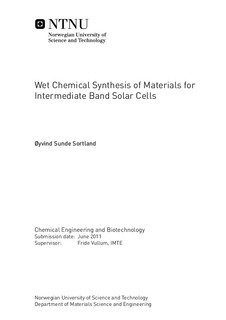| dc.description.abstract | The economical feasibility of commercial, single-junction solar cells is limited by high costs and limited efficiencies. New solar cell concepts and materials are sought to decrease the production costs and increase the efficiency. Intermediate band solar cells (IBSCs) show a promising concept for increased efficiency up to 46.77% as they employ three band gaps that can be matched to the solar spectrum to minimize fundamental losses. Doping of copper gallium disulphide (CuGaS2) with transition metals like Fe and Ni to high concentrations can theoretically form an intermediate band (IB), which for Fe doping gives nearly optimal band gaps for IBSC applications. Copper gallium disulphide is synthesized in an environmentally friendly, inexpensive and simple hydrothermal synthesis which may contribute to decreased costs of solar cell production.The hydrothermal synthesis is developed to produce copper gallium disulphide from copper(I) chloride (CuCl), gallium(III) chloride (GaCl3) and excess thiourea (Tu) (SC(NH2)2) in deionized water. The influence of varying synthesis parameters on product purity, yield and morphology has been investigated through X-ray diffraction (XRD) and scanning electron microscopy (SEM). Energy dispersive X-ray spectroscopy (EDS) is used to investigate doping of copper gallium disulphide and identify particle morphologies formed by different phases. Formation of copper gallium disulphide proceeds through slow decomposition of Tu, driven by an equilibrium shift due to hydrogen disulphide (H2S) evolution and precipitation of sulphides like the intermediate phase digenite (Cu2-δS) into which Ga3+ ions are incorporated. An additional impurity of copper(II) sulphide (CuS) is commonly formed, and gallium(III) hydroxyoxide (GaO(OH)) forms at pH > 0.5. Products of high purity and yield are obtained at 250 °C with concentrations above 0.060 M copper(I) chloride and gallium(III) chloride with the complexing agent 1-pentanethiol, and 0.319 M without 1-pentanethiol. Introducing nickel(II) chloride (NiCl2) or iron(III) chloride (FeCl3) in the hydrothermal synthesis forms vaesite (NiS2) or iron pyrite (FeS2) impurities, respectively, and copper gallium disulphide is not doped to a desirable concentration for IB formation.Color variations in the products reveal off-stoichiometries which contribute to a wide range of particle and crystallite morphologies within each product. Yellow, stoichiometric copper gallium disulphide particles have been deposited on a Si(100) substrate and growth of a red, Ga-rich film was achieved with 1-pentanethiol. These products were subject to photoluminescence spectroscopy (PL) along with off-stoichiometric powders of doped and undoped products, but no luminescence was obtained, possibly due to high defect densities and non-radiative recombination. Dispersions of powders were also subject to absorption spectroscopy which indicate extensive scattering due to wide ranges of particle sizes. The morphology of powder products shows particularly large variations within and between the products. Nanoplate and pyramidal crystallites are produced through nucleation and growth to form network structures and polycrystalline spheres, rods and rose-like particles, which along with the crystallites have varying irregularities and sizes. | nb_NO |

